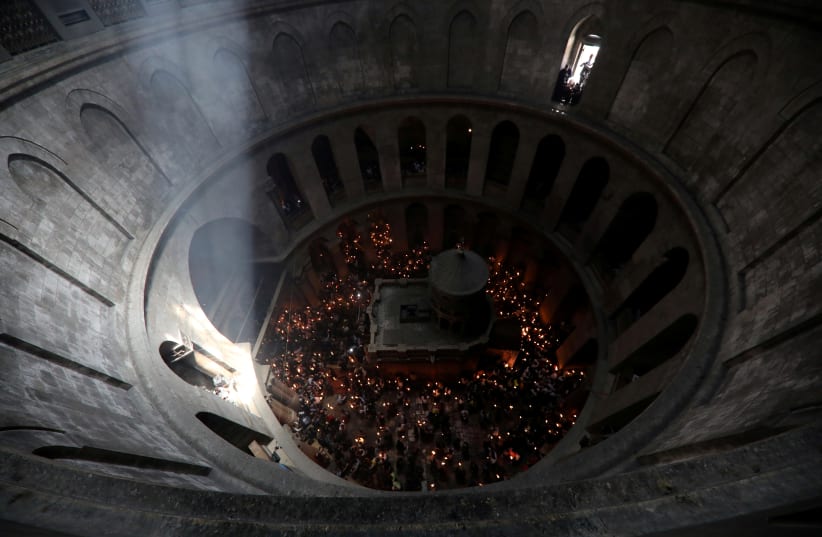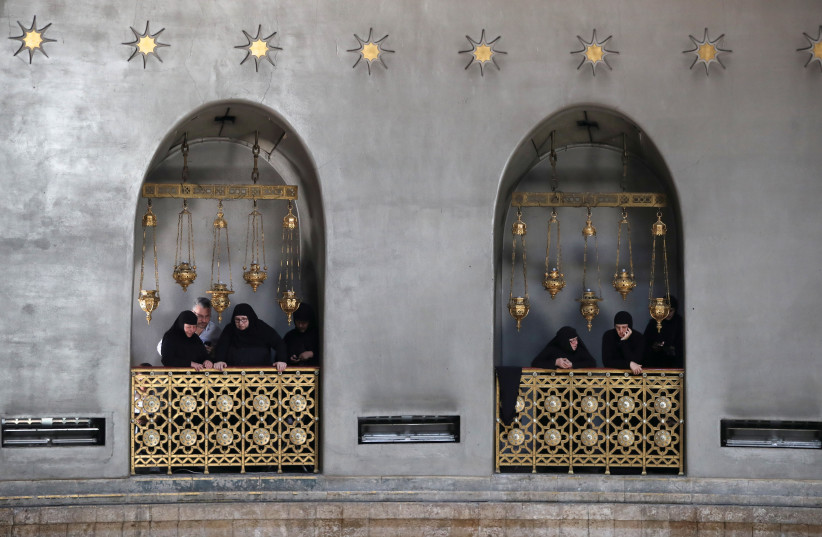The successful completion of the 2017 restoration of the Edicule, the structure within the Church of the Holy Sepulchre revered by Christians as the tomb of Jesus, was possible thanks to its implementation by a multi-disciplinary team, the Greek engineer who led the complex project said at a Jerusalem symposium April 4.
The use of expert scientific studies, as well as good communications with church leaders and complete financial transparency, also contributed to the project’s success despite the challenges presented working in a place with divided control, said engineer Dr. Antonia Moropoulou from the National Technical University of Athens who led the multi-disciplinary team.
Restoring a building or a monument of such religious, cultural and even political significance challenges experts not only to preserve the physical structure but also its spirit, said Moropoulou.
Organized by the EDICULA project, the symposium discussed conservation work on multi-cultural monuments using the Church of the Holy Sepulchre as an example.
The EDICULA project, an educational initiative formed following the restoration work on the church by Greek, Italian and Israeli institutions—including the Israel Antiquities Authority and Bezalel Academy of Arts—promotes multi-disciplinary learning to foster intercultural dialogue and approaches to the protect monuments. It uses an image of the restored Edicule as its emblem.
The nine-month-long restoration project began on June 2016 after Israeli police briefly shut down the building after the IAA deemed it unsafe. The multi-faceted work was completed in March 2017, just in time for Easter.
No restoration work had been carried out on the site in 200 years because of disagreements among the three major Christian communities with control over the church.
Moropoulou noted that after being called in by the Greek Patriarchate to formulate a work plan, she witnessed a culture of dialogue which had developed together with the Franciscan Custody of the Holy Land and the Armenian Patriarchate, which according to the 1852 Status Quo agreement share regulated custody of the Holy Sepulchre.
“In the short period I lived here, the image of Jerusalem changed in front of the international media from a place of conflict to a place of peace, union and mutual understanding,” Moropoulou said. “Fighting with forces opposing this change was most interesting, most challenging and the most important thing we can give to Jerusalem.”
It was necessary to use innovative methods to meet the goal while still allowing for the liturgical life of the church and its visitors to continue, she said. Work undertaken included repairing internal masonry of the shrine, inserting titanium bolts to reinforce the structure, and attempting to reinforce the condition of underground drainage channels and other unexplained tunnels beneath the floor of the rotunda where the Edicule is located. Also in the course of the work restorers were able to date a marble slab protecting a bedrock shelf inside the inner burial chamber to the 4th century, when Roman Emperor Constantine had the Church of the Holy Sepulchre built.
It was possible to do much of the work and understand the history of the site thanks to earlier mapping and archaeological work done by the IAA with the agreement of the churches, as well as consultations with Christian theologians and historians, Moropoulou added.
“Even though we work with the Status Quo, even though we work in a conflicting environment which is alive, even though we are collaborating with a lot of people, we have to develop freedom of information and knowledge,” she said.
The interdisciplinary character of the project and study of the historical evolution of the structure made it possible to support and integrate all decisions scientifically which greatly helped in the restoration process, Moropoulou said.
Publicizing the results of the continuing work to billions of people by National Geographic was another innovative tool which fostered a desire of cooperation and partnership among all the parties involved, she said.
“The work in the Church of the Holy Sepulchre was conflicting (in another way): it was (on one hand) the Jerusalem of mutual understanding and cooperation, of a peaceful creative effort with the other Jerusalem of conflict of terrorism and isolation (on the other) ,” Moropoulou said. “In these two worlds in conflict we were actually fighting not only for cultural heritage preservation, we were fighting of openness, for freedom, for open access of information for speaking a common language, for solving problems in real time. This is life, this is reality either you live it or not.”
The restoration work led to an agreement by the churches to continue with restoration work and a project to repair and reinforce the pavement stones of the church was initiated last month.
Professor of architecture Mike Turner of Bezalel Academy of Art, UNESCO Chairholder in Urban Design and Conservation Studies, who also spoke at the symposium said the peaceful discussions achieved within the confines of the Status Quo agreement can be used as an example for respecting different interpretations while completing work.
Whether the use of such a model would be possible in more conflictive sites, remains to be seen.

